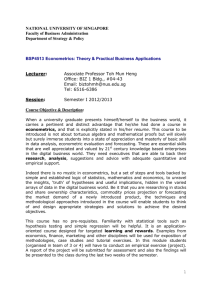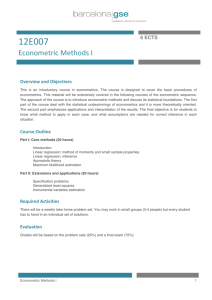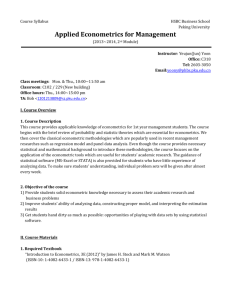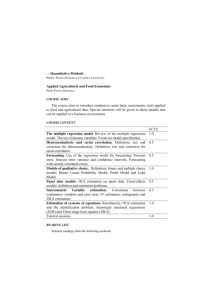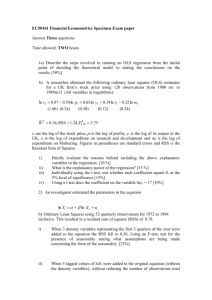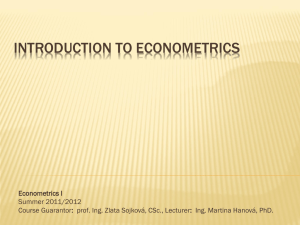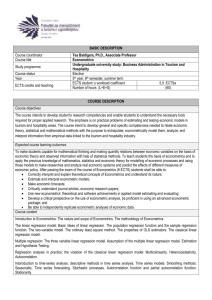Elements of Econometrics
advertisement
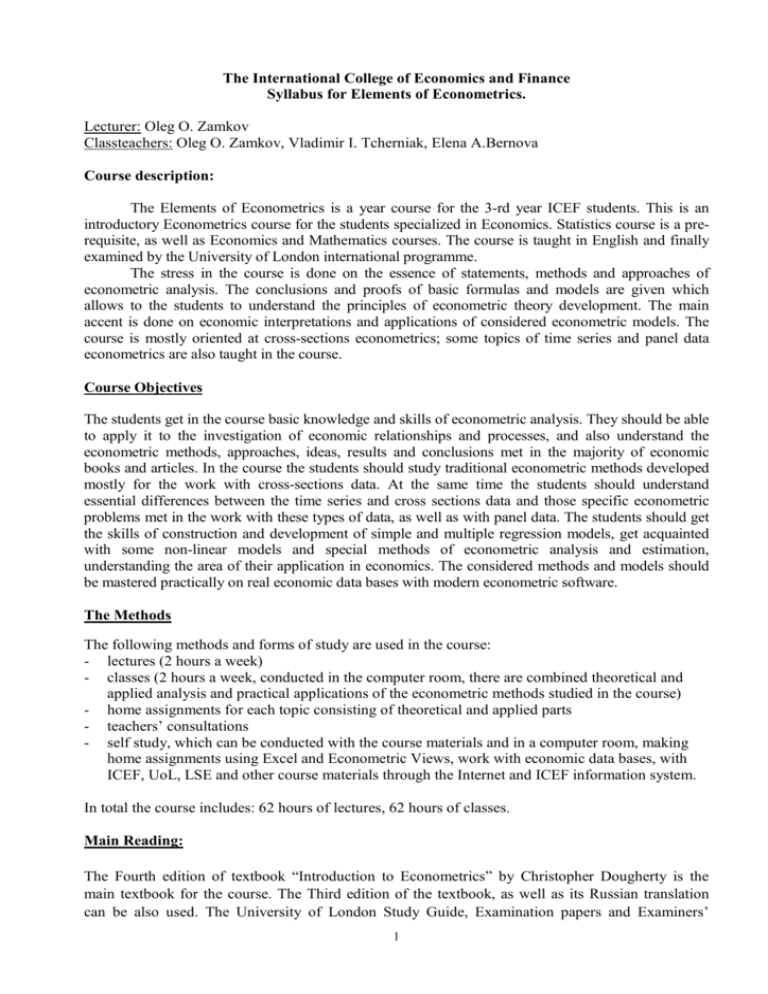
The International College of Economics and Finance Syllabus for Elements of Econometrics. Lecturer: Oleg O. Zamkov Classteachers: Oleg O. Zamkov, Vladimir I. Tcherniak, Elena A.Bernova Course description: The Elements of Econometrics is a year course for the 3-rd year ICEF students. This is an introductory Econometrics course for the students specialized in Economics. Statistics course is a prerequisite, as well as Economics and Mathematics courses. The course is taught in English and finally examined by the University of London international programme. The stress in the course is done on the essence of statements, methods and approaches of econometric analysis. The conclusions and proofs of basic formulas and models are given which allows to the students to understand the principles of econometric theory development. The main accent is done on economic interpretations and applications of considered econometric models. The course is mostly oriented at cross-sections econometrics; some topics of time series and panel data econometrics are also taught in the course. Course Objectives The students get in the course basic knowledge and skills of econometric analysis. They should be able to apply it to the investigation of economic relationships and processes, and also understand the econometric methods, approaches, ideas, results and conclusions met in the majority of economic books and articles. In the course the students should study traditional econometric methods developed mostly for the work with cross-sections data. At the same time the students should understand essential differences between the time series and cross sections data and those specific econometric problems met in the work with these types of data, as well as with panel data. The students should get the skills of construction and development of simple and multiple regression models, get acquainted with some non-linear models and special methods of econometric analysis and estimation, understanding the area of their application in economics. The considered methods and models should be mastered practically on real economic data bases with modern econometric software. The Methods The following methods and forms of study are used in the course: - lectures (2 hours a week) - classes (2 hours a week, conducted in the computer room, there are combined theoretical and applied analysis and practical applications of the econometric methods studied in the course) - home assignments for each topic consisting of theoretical and applied parts - teachers’ consultations - self study, which can be conducted with the course materials and in a computer room, making home assignments using Excel and Econometric Views, work with economic data bases, with ICEF, UoL, LSE and other course materials through the Internet and ICEF information system. In total the course includes: 62 hours of lectures, 62 hours of classes. Main Reading: The Fourth edition of textbook “Introduction to Econometrics” by Christopher Dougherty is the main textbook for the course. The Third edition of the textbook, as well as its Russian translation can be also used. The University of London Study Guide, Examination papers and Examiners’ 1 Report are also widely used in the course. Another (supplementary) recommended textbook is “Basic Econometrics” by D.N.Gujarati containing some extra course information, derivations, tests, proofs and applications. Useful information for the course can be found in the “Introductory Econometrics” by J.M.Wooldridge. The book by O.Zamkov (7) and ICEF teaching materials (8-9) are also used in the course. The books by Greene, Verbeek and Kennedy are recommended as supplementary reading: the first contains deeper presentation of course materials, the others – useful explanations and comments. ICEF Study Guide 2004 and 2010 editions supplement each other. 1. Dougherty, Christopher. Introduction to Econometrics. Oxford University Press, 2011, 2006 (4th or 3rd edition) (CD). Russian translation: Доугерти Кр. Введение в эконометрику. Изд.3. М., ИНФРА-М, 2009. 2. Dougherty, Christopher. Elements of econometrics. Study Guide. University of London. 2011. 3. Gujarati D.N. Basic Econometrics. McGraw-Hill, 4th edition, 2003 (Gu); 5th edition (2009, Gujarati D.N., and D.C.Porter). Supplementary reading 1. Магнус Я.Р., Катышев П.К., Пересецкий А.А. Эконометрика. Начальный курс. Изд. 8. М., Дело, 2007 (MKP). 2. Econometric Views User's Guide. Quantitative Micro Software, LLC. 3. Greene W.H. Econometric Analysis. Prentice Hall int. 5th ed., 2003, and earlier editions (Gr). 4. Kennedy P. A Guide to Econometrics. Blackwell Publishers, 6th edition, 2008, and earlier editions (K). 5. Verbeek, M. A Guide to Modern Econometrics. Wiley, 3rd edition, 2008, and earlier editions. Russian translation: М.Вербик, Путеводитель по современной эконометрике. М., «Научная Книга», 2008. 6. J.M.Wooldridge. Introductory Econometrics. A modern approach. 4th edition, Thompson SouthWestern, 2009 (W), and earlier editions. 7. Zamkov, Oleg. Econometric Methods in Macroeconomic Analysis. Moscow, Dialog-MGU, 1999 (OZ). Russian translation: Замков О.О. Эконометрические методы в макроэкономическом анализе. М., ГУ ВШЭ, 2001. 8. Zamkov O.O. Elements of Econometrics. Lecture motes. I-4, 2004-2012. In English and in Russian. 9. Zamkov O.O., Tcherniak V.I. Econometrics, Study Guide. ICEF materials, 2004, 2010. Internet resources 1. 2. 3. 4. 5. 6. 7. 8. 9. http://econ.lse.ac.uk/ie/ (I-1) http://www.oup.com/uk/orc/bin/9780199567089/ (I-2) http://www.oup.com/uk/orc/bin/9780199280964/ (I-2) http://highered.mcgraw-hill.com/sites/0072335424/ (I-3) http://www.londonexternal.ac.uk/current_students/programme_resources/lse/index.shtml (I-4) http://www.gks.ru (I-6). http://www.cbr.ru (I-7). http://mief.hse.ru (I-8). http://crow.academy.ru/econometrics (I-9) Software and data bases: The main software used in the course is Econometric Views (version 5.1 and later ones). Spreadsheet Excel is also used in the course. 2 For making class and home assignments the following data bases are used: data prepared by Christopher .Dougherty at the LSE (data for estimation of earnings functions based on NSLY survey at the USA; annual data on demand, disposable income and relative prices for aggregated goods and services in the USA, for 1959-2003 - the data is available at I-1); Monthly data for main macroeconomic indicators for Russia, 1992-2012 (I-6, I-7); Annual data for estimated GNP, labour and capital in USSR economy for 1928-1987. Grade determination: The students sit two mid-term written exams in October and in March, first semester written exam in December, and University of London International programme exam in May. October and December exams include multiple choice and free response parts. March and May exams are free response (open questions) exams. The first semester grade is determined as follows: December exam grade gives 50% of the grade, October exam - 30%, and 20% is given for home assignments. In the final course grade the University of London exam grade gives 40%, the first semester grade gives 30%, and 30% is given for the second semester (20% - for March exam and 10% for home assignments). The Course Outline. 1. Introduction to Econometrics. Statistical Investigation of Economic Variables' Relationships. Relationships in the economy: examples, problems of estimation and analysis (demand functions, earnings functions, economic growth models). Economic data: cross sections, time series, panel data. Main statistical concepts and facts used in the course. Data bases. Software. Course materials presentation. Review (CD), L.1 (OZ). 2. Simple Linear Regression Model (SLR) with Non-stochastic Explanatory Variables. OLS estimation. Simple Linear Regression Model: definitions and notation. SLR Model Estimation using Ordinary Least Squares (OLS). Expressions for the OLS estimators of slope coefficient and intercept: derivation and interpretation. Assumptions of the SLR models and the properties of OLS estimators. Gauss-Markov theorem (formulation). Standard deviations and standard errors of regression coefficients: derivation and interpretation. Statistical significance of OLS estimators: hypotheses testing using t-tests. Derivation and interpretation of confidence intervals. The general quality of regression: determination coefficient R2. F-statistics and F-tests. Relationship of R2 with correlation coefficients. SLR model without intercept. OLS-estimation, properties and applications. Chapter 1, Chapter 2 (CD), Chapter 3, Chapter 6 (6.1, Appendix 6A.1) (Gu), L.2 (OZ) 3. Multiple Linear Regression Model (MLR): two explanatory variables and k explanatory variables. 3 Derivation and properties of OLS-estimators of MLR with two explanatory variables. Determination coefficient R2. Adjusted R2. Testing hypotheses using t- and F-statistics. OLS-estimation of the model with k explanatory variables in vector-matrix form. Properties of coefficients’ estimators. F-test for groups of variables. Multicollinearity. Its consequences, detection and remedial measures. Estimation of production functions in volumes and growth rates' forms as multiple regression models. Making predictions using Multiple Linear Regression Model. Properties of predictors. Chapter 3 (CD), L.2,4 (OZ), Chapters 7-8, 10 (Gu), Chapter 3 (MKP). 4. Variables Transformations in Regression Analysis. Linear and Nonlinear regressions. Linearisation of non-linear functions and their estimation using Ordinary Least Squares. Disturbance term specification. Interpretation of linear, logarithmic and semilogarithmic relationships. Estimation of functions with constant elasticity and exponential time trends. Comparison of the quality of regression relationships: linear and semi-logarithmic functions. Box-Cox transformation. Models with quadratic and interactive explanatory variables: estimation and interpretation. Chapter 4 (CD), Chapter 6 (6.5-6.7) (Gu), L.4 (OZ). 5. Dummy Variables. Dummy variables in linear regression models. Reference category and dummy variables’ trap. Effects of change of the reference category. Types of dummy variables: intercept and slope dummies. Interaction dummies. Multiple sets of dummies. Chow test for structural break. Dummy group test.. Dummy variables in economic models: earnings functions, production functions. Dummy variables in seasonal adjustment. Chapter 5 (CD), Chapter 9 (Gu). 6. Linear Regression Model Specification. Consequences of Incorrect Specification. Omitting significant explanatory variable. Including unnecessary explanatory variable in the model. Monte-Carlo method in econometric analysis: general principles, areas of application and examples. Proxy Variables. Testing of linear restrictions on parameters of MLR: single and multiple restrictions, F-tests and ttests. Role and examples of linear restrictions in economic models. Model reparametrisation: interpretation and examples. Short run and long run effects. Lagged Variables in economic models. SLR model assumptions’ violation. General principles of consequences’ analysis, detection and correction. Generalised Least Squares (GLS). Chapter 6 (CD), Chapter 13 (13.3-13.4) (Gu). 7. Heteroscedasticity. 4 Concept, consequences and detection of heteroscedasticity. Goldfeld-Quandt and White tests. Model correction. Logarithmic regressions. Weighted Least Squares (WLS) method as a special case of GLS. White’s heteroscedasticity-consistent standard errors. Reasons and examples of heteroscedasticity in economic models. Chapter 7 (CD), Chapter 11 (Gu). 8. Stochastic Explanatory Variables. Measurement Errors. Stochastic explanatory variables in LR models. Model assumptions. Properties of OLS-estimators and test statistics of stochastic explanatory variables’ coefficients: finite sample and asymptotic. Measurement errors: reasons and consequences. Milton Friedman's critique on consumption function estimation: Permanent income hypothesis. Instrumental variables. Using instrumental variables in M.Friedman’s consumption model and in other economic models. Asymptotic properties of IV estimators. Durbin-Wu-Hausman (DWH) test. Chapter 8 (CD), Chapter 13 (13.5-13.6) (Gu) . 9. Simultaneous Equations Models. Concept of simultaneous equations model. Exogenous and endogenous variables. Predetermined variables. The simultaneous equations bias. Inconsistency of OLS estimators. Structural and reduced forms of the model. Model of demand and supply and simple Keynesian equilibrium model as simultaneous equations models. Identification problem. Exact identification, underidentification, and overidentification. Rules of identification. Order condition. Testing exogeneity: Durbin-Wu-Hausman test. Methods of estimation. Indirect Least Squares (ILS). Instrumental Variables. Two-Stages Least Squares (TSLS). Examples of simultaneous equations models estimation in Economic Analysis. Chapter 9 (CD), Chapters 18-20 (Gu), L.5 (OZ). 10. Maximum Likelihood Estimation. The idea of maximum likelihood estimation (ML). SLR and MLR Models Estimation using ML. ML Estimators’ properties. Test statistics (z-statistics, pseudo- R2, LR-statistic) and statistical tests. Chapter 10 (10.6) (CD), Chapter 4 (4.4, Appendix 4A) (Gu) 11. Binary Choice Models, Limited Dependent Variable Models. Linear probability model: problems of estimation. Logit-analysis. Probit-analysis. Using Maximum Likelihood for logit and probit models' estimation. Models’ interpretation and Marginal effects investigation. Examples of Binary Choice models in Economics. Censored samples. Direct and truncated estimation. Tobit-model: interpretation and ML estimation. Sample selection bias. Chapter 10 (CD), Chapter 15 (Gu). 12. Modelling with Time Series Data. Dynamic Processes Models. Time series data regressions: Model assumptions. Properties of OLS estimators. 5 Distributed lag models: geometrically distributed lags, polynomial lags. Koyck transformation and estimation of geometrical lag’s parameters. Autoregressive Distributed Lag (ADL) models. Interpretation and asymptotic properties. Partial adjustment. Adaptive expectations. Cagan hyperinflation model estimation. M.Friedman's permanent income model: problems of estimation and analysis. Vector autoregression. VAR model. Causality in Economics: Granger test. Chapter 11, Chapter 12 (CD), Chapters 17, 22 (Gu), L.5 (OZ). 13. Autocorrelated disturbance term. Signs and consequences of disturbance term’s autocorrelation in LR model. Durbin-Watson d-test for first order autocorrelation. Breusch-Godfrey (BG) test of higher-order autocorrelation. Autocorrelated disturbance term and model misspecification: apparent autocorrelation. Model correction: Autoregressive transformation. Cochrane-Orcutt (CO) procedure and non-linear estimation. Autoregressive transformation and transformed’ model estimation as a special case of GLS. AR, MA, ARMA models. AR(1) and ADL(1,0) models: Common factor test and model selection. Autocorrelated disturbance term in a model with lagged dependent variable as one of the explanatory variables. Durbin h-statistic and test. Autoregressive Conditional Heteroscedasticity (ARCH) model. Chapter 12 (CD), Chapter 12 (Gu), L.3 (OZ). 14. Time Series Econometrics: Nonstationary Time Series. Stationary and nonstationary time series. Definitions and examples of stationary and nonstationary time series. Random walk. Drifts and trends. Consequences of nonstationarity. Spurious regressions. Detection of nonstationarity. Correlograms. Unit root tests. Akaike ans Schwarz Information Criteria. Cointegration. Fitting models with nonstationary time series. Detrending. Error-correction models. Chapter 13 (CD), Chapter 21 (Gu). 15. Panel Data Models. Panel data: economic examples. Unobserved heterogeneity problem. Pooled regressions. Fixed effect regressions. Within-groups regression models. First differences regression models. Least squares dummy variables (LSDV) regression models. Random effect regressions. Fixed effects or random effects: Durbin-Wu-Hausman (DWH) test. Fixed effects or pooled regression: F-test. Chapter 14 (CD), Chapters 13-14 (W), Chapter 13 (MKP), Chapter 16 (Gu). Distribution of hours for topics and types of work No Topics titles 1. 2. Introduction to Econometrics. Simple Linear Regression Model (SLR) Explanatory Variables. OLS estimation. Contact hours Lectures Classes with 6 2 Non-stochastic 4 2 4 3. 4. 5. 6. 7. 8. 9. 10. 11. 12. 13. 14. 15. Multiple Linear Regression Model (MLR): two explanatory variables 6 and k explanatory variables. Variables Transformations in Regression Analysis. 2 Dummy Variables. 2 Linear Regression Model Specification. 4 Heteroscedasticity. 2 Stochastic Explanatory Variables. Measurement Errors. 4 Simultaneous Equations Models. 4 Maximum Likelihood Estimation. 2 Binary Choice Models, Limited Dependent Variable Models. 6 Modelling with Time Series Data. Dynamic Processes Models. 10 Autocorrelated Disturbance Term 4 Time Series Econometrics: Nonstationary Time Series. 8 Panel Data Models. 4 Total: 62 7 6 2 2 4 2 4 4 2 6 10 4 8 4 62



